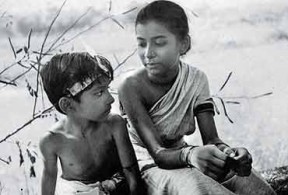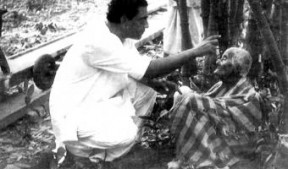Ray devised an innovative way to work around Apu’s stiffness and awkward gait. Like much of his journey into making the film, this also is a lesson for wannabe filmmakers:
“I had learnt a lesson. All my preparations over the years… had finally produced this one shot and it was difficult to imagine anything more lifeless and futile. I must say, though, that it didn’t take me long to decide that the thing could be rectified. I had simply had no idea that it was so difficult to make a single action like a boy’s walk appear convincing to the eye. What I now did was to provide mechanical aids to the boy. I planted Anil, Bansi and Ashish behind clumps of kaash in various positions at varying distances from each other. They were asked to call out ‘Subir’ (Apu’s real name) at certain intervals and Subir was to react to each call by turning his head in the direction it came from, though never stopping his walk. Then I put twigs on the path at irregular intervals for him to step across.”
The trick had its desired effect, and the shot was okayed. After shooting some more, they had sufficient funds left to shoot the following two weekends. But, as luck would have it, when Ray and his team went back the next Sunday, he was shocked to find that all the kaash flowers were gone, the fields were full of ‘uninspiring brownish grass’. Inquiring with a local revealed that a herd of cattle had come to graze and had cleaned it all off! For a short while, Ray considered dropping the scene with the flowers – but the unflinching genius in him refused to compromise. Hence, it was decided to suspend shooting for the time being and concentrate on rest of the casting and locations.
The village that was picked to represent Nishchindipur (the village in the novel), was a few miles from Calcutta, a place called Boral. Part of the village looked like a small town and did not serve the purpose. But the flora and fauna of the place made it suitable for the film. The team zeroed in one house that was similar to that in the book – it was a run-down, dilapidated old place that needed renovation. Ray met the owner, a certain Mr. Ghoshal, who stayed in Calcutta, and rented the house for Rs. 50 a month, on condition that they renovate the house and make it usable.
Art director Bansi Chandragupta swung into action and started constructing what was the most elaborate on-location set at that point of time in India. His experience of working with Jean Renoir in The River was of immense help. Bansi says,
“I made additions like exterior walls, doors, a kitchen… In reconstructing, we rejected all former methods and materials of set-building here. During work on The River, there had been a lot of experiment with materials to gain interesting textural effects… As the property must look old and used, I made use of plaster and brick. The reconstruction work was mainly done by plastering over bamboo mats. The use of plaster was something entirely new in Indian film production. It was chosen because plaster makes a very flexible material.”
Meanwhile, Ray was on the lookout for someone who could play the old Aunt, Indir. He came across some old actresses, but they, although in the right age group, were too senile to respond to his direction. And then he heard of Chunibala Devi. Chunibala was well in her eighties, a theatre actress of repute from an era when acting on stage by women was considered low brow and improper, almost akin to prostitution in some cases. As it turned out, even at 80-plus, Chunibala was in ‘full possession of her senses’. She was hired for Rs. 20 per day (she had asked for 10).
All this while, financing for the film was a constant worry. With nowhere to turn to, Ray & Co. decided to approach Dr. Bidhan Chandra Roy, the then Chief Minister of West Bengal. Dr. Roy was a stalwart and a giant in the Indian political arena of the time. He was an ace physician as well, who had the honour of having Mahatma Gandhi as his patient. Satyajit’s mother had a friend who was close to Dr. Roy. In a few days, he was called to the Chief Minister’s office. Dr. Bidhan Chandra Roy, on hearing Satyajit Ray’s narration of the story, decided that the film had to be financed under the “Community Development Project” of the Government of West Bengal. Ray nodded in silence.
The money was to be given by way of installments. With the first one being paid, the crew returned to shooting with renewed vigour and excitement. Countless memorable incidents occurred during shooting in this period. On one such occasion, Ray actually ‘needed’ somewhat heavy rainfall to happen, as he was shooting Durga’s dance ion the rain. Obviously, perfectionist as he was, he looked forward to ‘real’ rain rather than resorting to mechanical alternatives. Problem was, the rainy season in Bengal had passed.
“…the real rainy season was over. It meant that we had to go daily to the location with the children, praying for an off-season downpour… It took us three days to take the shots of the natural phenomena which took place in the vicinity in which we sat and waited. Shots of water lilies, dragonflies dancing over the foliage in a pond, banana leaves and lotus leaves swaying in a breeze, all these eventually found a place in scenes which were not in the book nor in my script… Eventually, it did rain heavily for over an hour in the middle of autumn in October. The scene was in the can and had come out very well.”
In 1954, Monroe Wheeler from the New York Museum of Modern Art arrived in Calcutta. On seeing parts of the film, Monroe wanted it to be a part of an exhibition he was planning the following year. With little time left, it was a desperate race to complete the film on schedule.
In the following months, master director John Huston (The Maltese Falcon, The Treasure of Sierra Madre) came to India, scouting locations for his film on Rudyard Kipling’s The Man Who Would Be King. A certain Mr. Gupta of JWT who was handling the PR, mentioned to Huston about this curious film being made by a commercial artist. Huston wished to see the film. On seeing the footage, he was genuinely impressed at the originality of voice. Huston offered whatever help he could offer, in any shape or form.
Meanwhile, shooting continued at a frantic pace. Ray turned his attention to background music – as composer, the first person he could think of was Sitar Maestro Pandit Ravi Shankar. Ravi Shankar arrived from Delhi for two days, of which he could afford only one day for composing the soundtrack. A screening was arranged in the afternoon – it took full 11 hours to complete the recordings!
Shooting of the film and the music taken care of, the only major aspect yet to be done was the editing. The final sound mixing and editing took 10 days:
“I had always believed that a third of a man’s life is given to sleep, if eight hours sleep was considered the optimum. The final editing of Pather Panchali, followed by the mixing of the sound track, took 10 days and nights in which I didn’t sleep at all, while my editor Dulal Dutta fell asleep for half- an- hour, lying on the floor of the cutting room, flat on his back, with yards of cuttings strewn all around him. As I attempted to wake him up with a faint nudge, he moaned, “No more, not any more please.” But he did wake up with a Herculean effort and resumed working. The other members of the crew including my assistants and assistants to the editor, would take short snoozes lying on the floor, or on a table or in a couple of armless chairs placed side by side.”
The first print of Pather Panchali came out late night. The next morning, without even a final look at the print, it was rushed to the Pan Am office to be shipped to the US.
Ray, it is said, fell asleep while talking to the receptionist at the Pan Am Office.
[This series of articles have heavily drawn from Satyajit Ray’s “My Years with Apu” and “Satyajit Ray: Portrait of a Director” By Marie Seton]
[youtube=http://www.youtube.com/watch?v=v5V7H4VPbXo]
Amborish Roychoudhury is a film enthusiast and a film buff who lives within this outer shell of a finance professional. He is extremely passionate about films, comics, old Hindi film music, detective fiction, technology and the like – He worships many deities but works for the devil! Another Blog that he write occasionally ishttp://amborish.posterous.com/or just go to amborish.com







